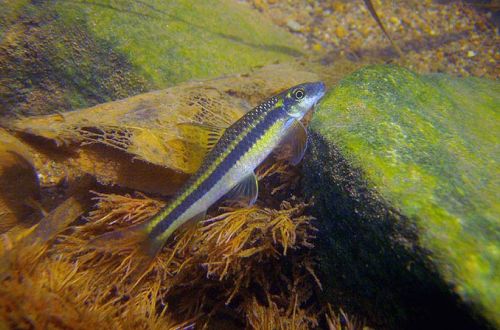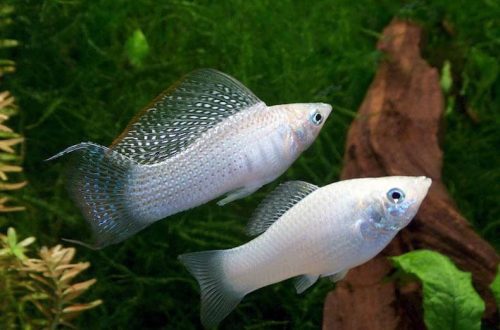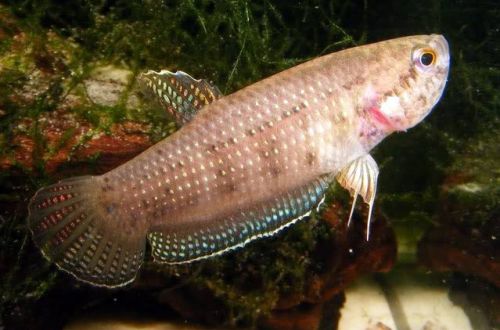
Garra Cambodian
False Siamese algae eater or Cambodian Garra, scientific name Garra cambodgiensis, belongs to the family Cyprinidae (Cyprinidae). Herbivorous fish from mountain streams. The content is due to the need to maintain a very high quality of water and to provide a sufficiently strong internal current. Breeding is difficult. The fish is not recommended for the beginner aquarist.

Contents
Habitat
The fish is native to Southeast Asia from the Idochina Peninsula. Inhabits the basin of the region’s largest river, the Mekong. It is found in the territories of Thailand, Laos, Cambodia and Vietnam. Inhabits the upper reaches of fast-flowing rivers. The water in these places is clear, rich in oxygen, the substrates consist of stones and boulders.
Brief information:
- The volume of the aquarium – from 250 liters.
- Temperature – 20-27°C
- Value pH — 6.0–7.5
- Water hardness – soft or medium hard (1-15 dGH)
- Substrate type – any
- Lighting – bright
- Brackish water – no
- Water movement – moderate
- The size of the fish is 12–15 cm.
- Nutrition – any feed with a predominance of plant products
- Temperament – peaceful
- Content in a group of at least 3–4 individuals
Description
Adults reach a length of 12–15 cm. The body pattern resembles a Siamese algae eater that lives in the same region. It has a striped body with a silvery belly with a gray back and a wide black stripe stretching from head to tail, bordered on top by a golden stripe.
Sexual dimorphism is weakly expressed. Visible differences appear during the spawning period, when males develop red pigmentation around the mouth, and small but numerous tubercles on the head.
Food
In nature, it feeds on a raid of algae, an abundance of boulders covering the surface. The basis of the daily diet can be spirulina-based foods, pieces of vegetables such as cucumber, melon, zucchini, etc. However, this is not a completely herbivorous species. In addition to plant-based foods, protein foods such as bloodworms, shrimp meat chunks, and dry kibbles should be fed.
Maintenance and care, arrangement of the aquarium
The optimal size of the aquarium for 3-4 fish starts from 250 liters. In the design, it is recommended to create an imitation of a mountain river flow with a substrate of stones, sand, fine gravel. Additionally, you can place several snags, with plants attached to them that can grow on a woody surface. For example, anubias, bolbitis mosses, Javanese moss and others.
When keeping Harrara Cambogia long-term, it is important to ensure internal flow, high water quality and high dissolved oxygen concentrations. A powerful filtration system will cope with this task. The flow rate should be about 10 revolutions per hour of the volume of the aquarium. This means that with a volume of water of 250 liters, the filter must pump 2500 liters of water through itself in one hour.
Bright lighting will stimulate the growth of algae on the surface of the stones, which will complement the diet.
Behavior and Compatibility
It is distinguished by a peaceful disposition, if it is in the company of relatives. When kept separately from representatives of its own species, it can behave aggressively towards other neighbors in the aquarium. It is advisable to acquire a group of at least 3-4 individuals, while the False Siamese algae eater will not form a flock. The fish will be kept separate.
Breeding / breeding
Breeding in a home aquarium is probably impossible. According to a study published in the 3 book Induced Spawning and Early Development of Stonelapping Minnow (ISBN 86004-182-7-399: 2004), artificial spawning was stimulated by the use of hormones. The resulting eggs had a short incubation period of 15–16 hours at a temperature of 25–29°C. The survival rate of fry was more than 90% in the first month.
Fish diseases
The main cause of most diseases is unsuitable living conditions and poor-quality food. If the first symptoms are detected, the water parameters and the presence of high concentrations of hazardous substances (ammonia, nitrites, nitrates, etc.) should be checked first. If necessary, bring the indicators back to normal and only then proceed with treatment. Read more about symptoms and treatments in the Aquarium Fish Diseases section.





